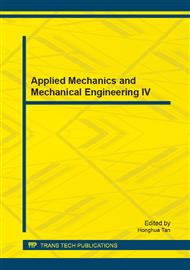p.3
p.7
p.11
p.18
p.26
p.34
p.40
p.46
p.51
Molecular Dynamics Simulation of Stick-Slip Friction on a Metal Surface
Abstract:
Friction on the atomistic scale was simulated using a molecular dynamics model consisting of a slider and substrate. The slider is in contact with the substrate through interatomic forces, while being pulled by a spring connected to a tractor moving parallel to the substrate surface at a constant velocity. The frictional force, which is defined as the force working on the connecting spring, is registered as the slider moves over the substrate, and consequently stick-slip behavior is observed. The static frictional force is higher if the lattice mismatch between slider and substrate is smaller. The sliding velocity affects whether atoms can rapidly settle into a stable site, and hence affects the kinetic friction; at high velocities, the atoms are forcibly moved resulting in a smaller kinetic friction force and a steady force curve.
Info:
Periodical:
Pages:
26-33
Citation:
Online since:
October 2013
Authors:
Price:
Сopyright:
© 2014 Trans Tech Publications Ltd. All Rights Reserved
Share:
Citation:


